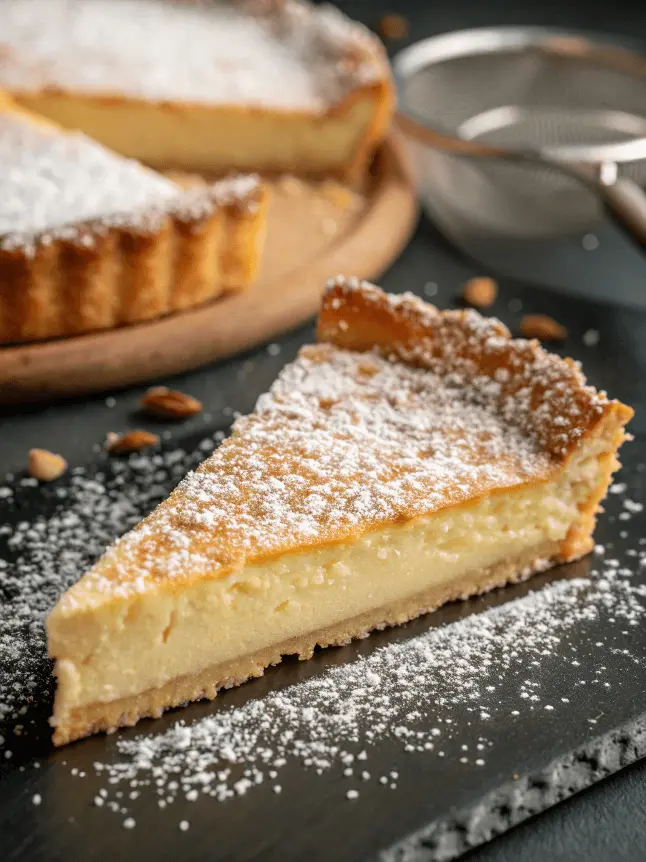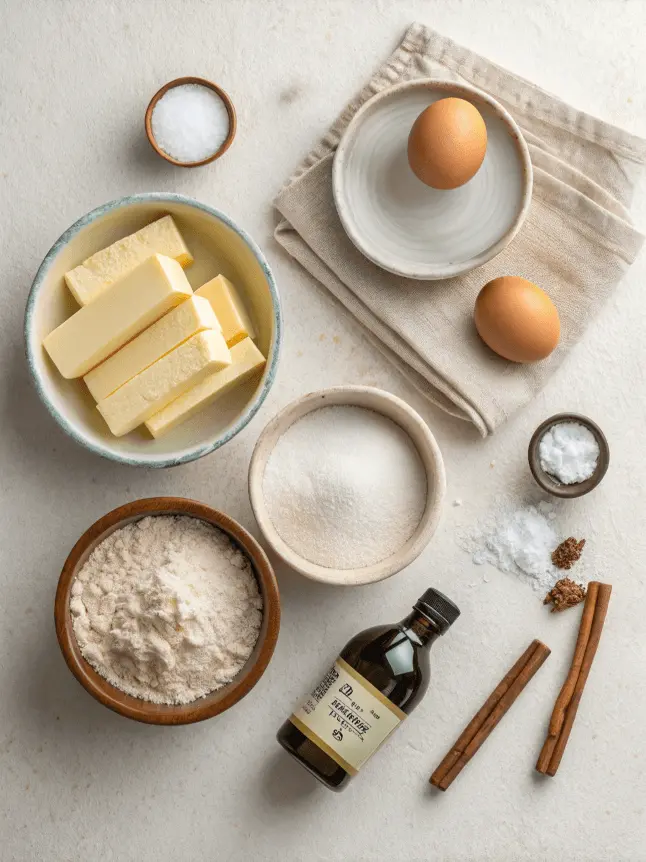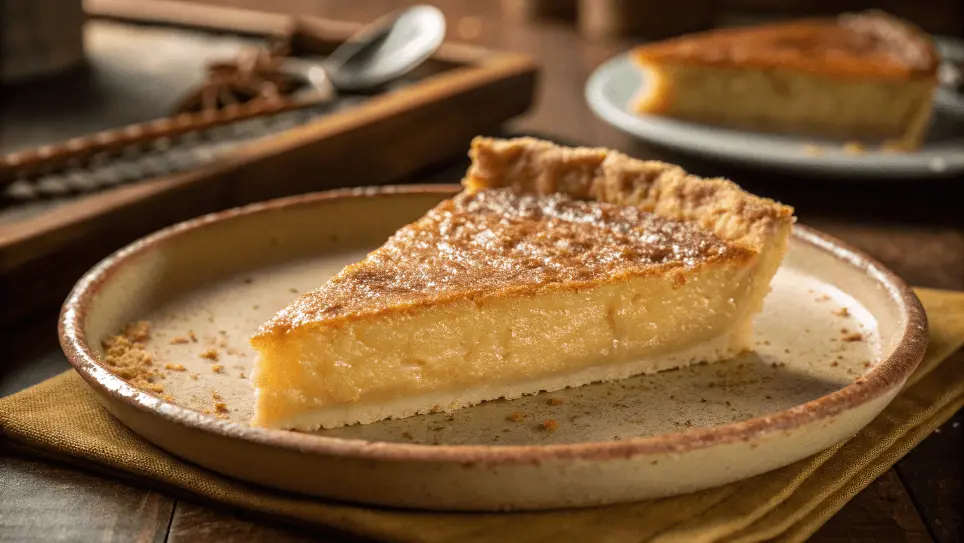Have you ever heard of a pie that uses water as its main ingredient? Sounds a little strange, right? But that’s exactly what makes water pie so fascinating! This old-fashioned dessert comes from the Great Depression era, when people had to get creative with minimal ingredients. What does water pie taste like? Imagine a light, custard-like filling with a touch of buttery sweetness, almost like magic in every bite. It’s the kind of dessert that surprises you with how simple yet delicious it is.
Now, here’s the best part—it’s incredibly easy to make! You don’t need fancy ingredients or hours in the kitchen. First, mix up a few pantry staples, then let the oven do the rest. In no time, you’ll have a slice of history on a plate. Ready to discover the charm of water pie? Keep reading to learn why this humble dessert is making a big comeback!
Table of Contents
The Unique Flavor of Water Pie

Is Water Pie Sweet or Savory?
Water pie is surprisingly sweet, but it’s not overpowering. If you’ve ever had a light custard pie, you’re on the right track. The main ingredients—sugar, butter, and a hint of vanilla—create a delicate sweetness that feels nostalgic. First, you’ll notice a buttery richness as you take a bite. Then, the sugar adds a gentle sweetness that melts in your mouth. It’s not as bold as a chocolate or fruit pie, but it has a comforting, old-fashioned taste.
Unlike super sugary desserts, water pie has a balanced flavor. The crust provides a slight crispiness, while the filling stays soft and smooth. Some say it reminds them of a mild vanilla pudding, while others compare it to a light caramel glaze. If you prefer subtle flavors over heavy desserts, this pie is a perfect choice.
One of the best things about water pie is how it changes with small tweaks. Some people like adding cinnamon for warmth, while others enjoy a dash of nutmeg for a richer taste. You can even experiment with toppings like whipped cream or a sprinkle of brown sugar for extra depth.
Here’s a quick breakdown of its sweet vs. savory elements:
| Flavor Element | Sweet or Savory? |
|---|---|
| Butter | Slightly savory |
| Sugar | Sweet |
| Vanilla | Sweet |
| Flour | Neutral |
| Crust | Slightly savory |
If you’re looking for something simple, cozy, and lightly sweet, this pie is a must-try. It’s not too rich, not too plain—just the right mix of old-fashioned charm and delicate sweetness. Next time you’re in the mood for a classic dessert, give it a try!
How the Texture Affects the Taste
The texture of water pie is just as unique as its taste! It’s soft, smooth, and slightly gooey, but it still holds its shape when sliced. Imagine a cross between a light custard and a gentle caramel glaze. The filling looks fragile, but it’s sturdy enough to melt on your tongue.
First, the top of the pie forms a thin, golden crust during baking. This gives a slight contrast to the creamy middle. When you cut into it, you’ll notice a soft but firm consistency—not as runny as pudding, yet not as dense as cheesecake.
The way the pie is baked also affects its final texture. If you let it chill longer, it firms up more. But if you serve it warm, it stays extra gooey and velvety. Some say the texture reminds them of a light butterscotch filling, while others think of it as a delicate syrupy custard.
Here’s how the texture compares to other familiar desserts:
| Dessert | Texture Comparison |
|---|---|
| Custard Pie | Softer but similar |
| Chess Pie | Less firm, more gooey |
| Pudding | More solid than pudding |
| Caramel Sauce | Lighter but with a similar melt-in-your-mouth feel |
The crust also plays a role. A flaky, buttery crust gives a nice contrast to the soft filling. Some bakers even double-bake the crust for extra crunch!
If you love silky, melt-in-your-mouth desserts, water pie is a treat worth trying. Whether you like it warm or chilled, its delicate, creamy bite will keep you coming back for more!
What Ingredients Give Water Pie Its Flavor?

The Role of Butter and Sugar
Butter and sugar are the real stars when it comes to water pie’s flavor. They work together to create a dessert that is both rich and sweet, yet not overpowering. If you’ve ever had a light caramel glaze or a buttery shortbread cookie, you’ll recognize some of those same flavors in every bite.
First, butter adds a warm, creamy richness. As the pie bakes, the butter melts and blends with the sugar, creating a soft, velvety filling. This helps balance the sweetness, making sure it’s smooth and not too sharp. A good-quality butter makes a big difference! The more buttery the pie, the more it resembles a classic custard but with a melt-in-your-mouth twist.
Sugar, on the other hand, is what brings the sweetness to life. Unlike heavily sweet pies like pecan pie, water pie has a lighter, more delicate sweetness. This is because the sugar dissolves into the water, creating a thin syrup-like layer that caramelizes slightly as it bakes. The result? A golden, glossy topping and a smooth, silky texture underneath.
Here’s how butter and sugar work together in water pie:
| Ingredient | Function | Effect on Flavor |
|---|---|---|
| Butter | Adds fat and richness | Creates a smooth, creamy texture |
| Sugar | Provides sweetness | Gives a delicate, caramel-like taste |
| Butter + Sugar | Blend together during baking | Forms a syrupy, glossy layer |
If you love simple, buttery desserts, water pie is a treat you need to try. The balance between butter and sugar makes it light yet satisfying, without being too rich. The best part? The texture and flavor only get better as it cools!
Water pie is definitely sweet, but in a delicate, understated way. Unlike bold desserts like chocolate cake or rich peach cobbler, water pie has a mild, buttery sweetness that melts in your mouth.
The Subtle Notes of Vanilla and Flour
Vanilla and flour may seem like simple ingredients, but they play a big role in how water pie tastes. Without them, the pie would feel flat and one-dimensional. Together, they add warmth, depth, and just a touch of familiar sweetness.
Vanilla gives the pie a soft, comforting aroma. When baked, it brings out the natural sweetness of the sugar while making the buttery flavors even smoother. It’s like the secret ingredient that ties everything together! Even though it’s not the strongest flavor in the pie, you’d definitely notice if it was missing.
Flour, on the other hand, helps with both texture and taste. Since water pie doesn’t have eggs or thick cream, flour helps hold everything together. It absorbs some of the water and butter, creating a light, custard-like consistency. Without flour, the filling would be too watery and wouldn’t set properly.
Here’s how each ingredient enhances the pie:
- Vanilla: Adds a warm, sweet aroma and enhances the sugar’s flavor.
- Flour: Gives structure and creates a smooth, creamy texture.
- Together: They balance the richness from the butter and sugar.
The way these ingredients interact makes water pie taste more complex than you’d expect from such a simple dessert. Even though the pie uses just a few pantry staples, it comes together beautifully, delivering a comforting, nostalgic bite every time.
Here’s the simplified table for better clarity:
| Flavor Element | Contribution to Water Pie |
|---|---|
| Vanilla | Adds warmth and sweetness |
| Flour | Creates a smooth texture and helps the pie set |
| Sugar | Brings sweetness and light caramel-like notes |
| Butter | Adds richness and depth |
If you’re intrigued, why not try making it yourself? Follow this water pie recipe and experience this charming dessert firsthand!
How Water Pie Compares to Other Classic Pies
Is Water Pie Similar to Chess Pie?
Water pie and chess pie may look alike, but their flavors and textures set them apart. If you’ve ever had chess pie, you know it’s rich, thick, and super sweet. Water pie, on the other hand, is lighter, less sweet, and has a more delicate texture.
One major difference comes from the ingredients. Chess pie is made with eggs, cornmeal, and a lot of sugar, which gives it a dense, custard-like filling. Water pie skips the eggs and cornmeal, making it softer and silkier. This difference affects how each pie feels when you take a bite. Chess pie is firm and heavy, while water pie is light and almost melts in your mouth.
Another key difference is the flavor profile. Chess pie has a deep, caramelized sweetness because of the high sugar content and eggs. It often includes vinegar or lemon juice, adding a subtle tang. Water pie, in contrast, has a gentler, buttery sweetness without any tangy notes. The vanilla gives it a smooth, comforting taste, making it feel simple yet nostalgic.
Here’s a quick comparison of water pie vs. chess pie:
| Feature | Water Pie | Chess Pie |
|---|---|---|
| Texture | Soft, silky, and light | Thick, firm, and dense |
| Sweetness | Mild and delicate | Very sweet and rich |
| Main Ingredients | Butter, sugar, water, vanilla | Eggs, sugar, cornmeal, vinegar |
| Flavor Notes | Buttery and smooth | Caramel-like with a hint of tang |
If you love lighter, more delicate desserts, water pie is a great alternative to chess pie. It’s simpler, smoother, and easier to eat, especially if you prefer a less sugary treat!
Does Water Pie Taste Like Custard Pie?
Water pie and custard pie share some similarities, but they are definitely not the same. If you’ve had a classic custard pie, you might expect water pie to taste similar, but there are a few key differences.
First, custard pie has a creamy, egg-based filling. The eggs give it a rich, pudding-like texture that holds together firmly. Water pie, however, does not contain eggs, making it softer, lighter, and more delicate. Instead of a thick, creamy bite, water pie has a smooth, melt-in-your-mouth consistency.
The flavor is also milder in water pie. Custard pie has a strong eggy sweetness, often with hints of nutmeg or cinnamon. Water pie, in contrast, has a buttery, vanilla-infused taste with a lighter sweetness. It’s less rich, making it a great choice for people who prefer simple flavors.
Key Differences Between Water Pie and Custard Pie:
- Egg Content: Custard pie uses eggs for structure; water pie does not.
- Texture: Water pie is softer and silkier, while custard pie is thicker.
- Sweetness: Custard pie has a more pronounced sweetness with deeper flavors.
- Flavor Profile: Water pie tastes lighter and more buttery, while custard pie has an eggier, richer taste.
Texture and Sweetness Levels Comparison:
| Pie Type | Texture | Sweetness Level |
|---|---|---|
| Water Pie | Soft, silky, and light | Mild and delicate |
| Custard Pie | Firm, creamy, and thick | Rich and slightly eggy |
If you enjoy light, smooth, and comforting desserts, water pie is worth trying. It’s like a delicate, silky version of custard pie—perfect for those who love a touch of sweetness without the heaviness of a traditional custard filling!
Can You Enhance the Flavor of Water Pie?
Adding Spices or Citrus for More Depth
Water pie is known for its simple, buttery sweetness, but you can easily enhance its flavor with a few creative additions. Adding spices or citrus can bring out new layers of taste while keeping the pie’s delicate texture intact.
First, let’s talk about spices. A dash of cinnamon, nutmeg, or allspice can give water pie a warm, cozy flavor. These spices are great for adding a touch of depth without overpowering the classic vanilla-butter base. If you enjoy spiced holiday desserts, a sprinkle of cinnamon on top before baking can create a comforting, seasonal feel.
Next, consider citrus zest. Adding lemon or orange zest to the filling can give the pie a bright, refreshing twist. The natural oils from the zest help balance the buttery richness, making each bite feel lighter and more vibrant. A little bit goes a long way—too much citrus can overpower the delicate sweetness of the pie.
Here’s a quick comparison of spice and citrus flavor enhancements:
| Ingredient | Effect on Flavor | Best Pairing |
|---|---|---|
| Cinnamon | Adds warmth and slight sweetness | Great with vanilla |
| Nutmeg | Brings a nutty, slightly spicy depth | Pairs well with butter |
| Lemon Zest | Adds a fresh, citrusy brightness | Balances rich flavors |
| Orange Zest | Slightly sweet and tangy | Enhances vanilla notes |
If you love classic, buttery desserts but want to switch things up, adding spices or citrus zest is an easy way to make water pie even more exciting!
Topping Ideas to Elevate the Flavor
Toppings can take water pie from simple to spectacular with just a few extra touches. Since the pie itself has a light, silky texture, toppings can add contrast, making every bite more enjoyable.
One of the easiest ways to enhance the flavor is by adding whipped cream. A dollop of lightly sweetened cream adds a smooth, airy texture that complements the pie’s soft filling. If you prefer something richer, a drizzle of caramel or honey can bring out the buttery flavors even more.
For those who enjoy a little crunch, consider crushed nuts. A sprinkle of toasted pecans or almonds can provide a satisfying contrast to the creamy filling. Another great option is graham cracker crumbs or cinnamon sugar, which add a little texture without making the pie too heavy.
Popular Topping Ideas for Water Pie:
- Whipped Cream: Light and airy, adds a soft texture.
- Caramel Drizzle: Brings out the buttery sweetness.
- Honey Glaze: A natural, mild sweetness that pairs well with vanilla.
- Toasted Nuts: Adds crunch and a nutty contrast.
- Cinnamon Sugar: Enhances the warm, cozy flavors.
- Powdered Sugar: A simple dusting makes the pie look extra fancy.
Best Toppings for Different Flavor Profiles:
| Topping Type | Flavor Impact | Best For |
|---|---|---|
| Whipped Cream | Light, creamy, slightly sweet | Classic, soft texture lovers |
| Caramel Sauce | Rich, buttery, deep sweetness | Fans of indulgent desserts |
| Honey | Mild, floral sweetness | A natural alternative to sugar |
| Toasted Nuts | Crunchy, nutty depth | Those who like texture contrast |
| Cinnamon Sugar | Warm, spiced sweetness | Lovers of cozy flavors |
Adding toppings is an easy way to customize the taste and texture of water pie without changing its original charm. Whether you like it simple or dressed up, these additions will make it even more delicious!
Looking for gluten-free dessert ideas? Check out are corn tortillas gluten-free? to learn more about naturally gluten-free ingredients.
Frequently Asked Questions (FAQs)
Is water pie the same as chess pie?
No, water pie and chess pie are different! Chess pie is richer and denser because it contains eggs and cornmeal. Water pie is lighter and silkier, with a gentle buttery sweetness. Chess pie also has a more caramelized taste, while water pie keeps things simple. If you love smooth, delicate desserts, water pie is a must-try!
What does shoofly pie taste like?
Shoofly pie has a deep, molasses-like sweetness with hints of brown sugar and spice. It’s much richer than water pie and has a crumbly, cake-like texture. Water pie, on the other hand, is silky, buttery, and mild in sweetness. Shoofly pie is for those who love bold flavors, while water pie is perfect for a light, nostalgic treat!
Does hot water crust taste good?
Yes, hot water crust is delicious and super sturdy! It has a rich, buttery flavor with a slightly crispy texture. Unlike flaky pie crusts, it’s denser and holds its shape well. It’s often used for meat pies but can work for sweet pies too. If you love a firm, crunchy crust that soaks up flavors, this one is for you!
What did Americans eat during the Great Depression?
People ate simple, affordable meals like water pie, potato soup, and cornbread. Stretching ingredients was key! Families made dishes like bean stews, rice casseroles, and biscuits to make food last. Desserts like water pie proved you could create something sweet with just a few pantry staples. It was a time of creativity in the kitchen, turning basic ingredients into comforting meals!
Final Thoughts: Should You Try Water Pie?
Absolutely! Water pie is a simple, nostalgic dessert that proves you don’t need fancy ingredients to create something delicious. First, it has a smooth, buttery texture with a mild, sweet flavor. Then, it surprises you with its soft, melt-in-your-mouth consistency. If you love light, comforting desserts, this one is a must-try.
Also, it’s easy to customize. Add cinnamon, citrus zest, or a drizzle of caramel to make it your own. Next, top it with whipped cream or toasted nuts for extra flavor. In addition, it’s budget-friendly and perfect for baking when you’re low on ingredients.
So, what does water pie taste like? It’s light, buttery, and delicately sweet, making it a cozy treat for any occasion. Give it a try! You might just discover your new favorite old-fashioned dessert. Now, who’s ready for a slice?

